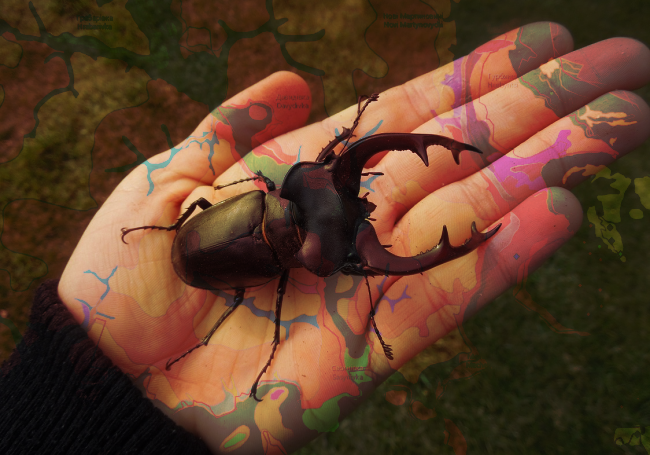
Попри те, що термін “геопросторовий” стає все більш вживаним, для багатьох все ж залишається незрозумілим значення цього слова. Від себе можемо сказати, що зі списку причин для найскорішого вивчення базових навичок геоматики можна зробити окремий пост. Але цього разу ми не будемо вас переконувати у неперевешеності геоінформаційних систем, а запропонуємо деякі можливості для практичного їх опанування.
Нижче ви побачите список курсів від різних інтернет-платформ, що допоможуть вам познайомитися (або стати більш обізнаними) з ГІС у якості інструменту для створення мап, картографування змін, просторового аналізу, дистанційного зондування й для створення крутої інфографіки.
У цей список ми намагалися включити курси для новачків і для професіоналів, отжесподіваємось, що кожен читач зможе знайти щось цікаве саме для себе. А ще для деяких курсів вам дуже стане у нагоді знання англійської мови!
1. Geospatial Intelligence & the Geospatial Revolution
Геопросторова Кмітливість та Геопросторова Революція
Рівень: Початковий/середній
Тривалість: 5 тижнів
Часові інвестиції: 6-9 годин/тиждень
Мова викладання: англійська
Початок курсу: 5 лютого, або майбутні сесії
Наші з вами життя дуже змінились завдяки геопросторовим технологіям.
Як саме і наскільки – буде пояснено у цьому курсі.
Протягом останніх років наше суспільство пройшло шлях від використання паперових мап до неймовірно просунутих автоматизованих технологій. Окрім позбавлення нас від необхідності брати з собою у подорож купу паперових мап, які ще геопросторові можливості запаковані в наші смартфони?
Протягом 5-х тижнів ви отримаєте огляд розвитку супутникових технологій, глобального позиціонування (GPS) та безпілотних літальних апаратів (дронів). Також тут пояснять, як наше бачення і сприйняття реальності змінюється з безпровідними комунікаціями, кишеньковими комп’ютерами та можливістю миттєво замінити трудомісткий аналіз на мапі автоматизованим процесом.
Курс проводиться доктором Тодом Бакастоу, професором Практики Геопросторової Кмітливості, Державний Університет Пенсильванії.
І хоча цей курс вже розпочався 5-го лютого, ви все ще можете долучитися до нього для ознайомлення з лекціями та матеріалами курсу, або ж підписатися на наступні сесії.
Раді вас вітати у геопросторовій революції!
2. Sensing Planet Earth – Water and Ice
Зондування планети Земля – вода і лід
Рівень: Початковий
Тривалість: 5 тижнів
Часові інвестиції: 6 годин/тиждень
Мова викладання: англійська
Початок курсу: 21 березня , 2016
Земля − це прекрасне місце для проживання.
З цим твердженням важко не погодитись, але… всі ми бачили тривожні новини про льодовики, що тануть, про рівень океану, що підіймається, про повені та урагани, сильніші ніж будь-коли. Так що ж саме коїться з нашою планетою? Як швидко стаються зміни? Як ми можемо відділити драму в медіа від науково обґрунтованої реальної зміни? Наскільки великий вплив людської діяльності?
Цей курс допоможе навчитися знаходити надійні дані для аналізу процесів складних систем Землі. Кілька способів моніторингу Землі за допомогою дистанційного зондування будуть представлені протягом курсу.
Навчитися шпигувати за власною планетою − звучить захоплююче, чи не так?
3. Going Places with Spatial Analysis
Відвідуючи місця з просторовим аналізом
Рівень: Початковий/впевнений
Тривалість: 6 тижнів
Часові інвестиції: 2-3 години/тиждень
Мова викладання: англійська
Початок курсу: 11 травня, 2016
Гарна можливість спробувати роботу з програмним забезпеченням ArcGIS Online на курсі, розробленому професіоналами ESRI та під їх чутливим керівництвом.
Одна з ідей цього курсу − ознайомити представників бізнесу або державних структур з важливістю урахування просторової локації для ефективного прийняття рішень, тож цей курс підійде людям з мінімальною кількістю знань про геоінформаційні системи.
В цьому курсі ви отримаєте не тільки теоретичні знання щодо просторових даних і просторового аналізу, але й самі візьмете участь у робочому процесі аналізу реальних даних у хмарних картографічних середовищах.
4. Do-It-Yourself Geo Apps
Гео застосунок: зроби сам
Рівень: Середній/професіонал
Тривалість: 4 тижні
Часові інвестиції: 3-4 години/тиждень
Мова викладання: англійська
Початок курсу: 20 липня, 2016
Цей масовий відкритий онлайн курс (MOOC) розроблений лідером індустрії для кожного, хто хотів би розробити власний застосунок, що потребує просторового виміру. Протягом одного місяця навчання, ви дізнаєтесь, як мобільні гео додатки здатні змінити на краще життя в вашому мікрорайоні, або як зобразити якусь історію на мапі, а також які джерела відкритих даних можна використовувати для розробки власного мобільного застосунку.
Хочемо привернути вашу увагу, що цей курс побудовано таким чином, щоб його могли відвідувати і програмісти, і ГІС-ентузіасти, вибираючи найбільш цікаві для себе модулі.
5. Exploring Humans’ Space: An Introduction to Geographicity
Дослідження людського простору: вступ до географічності
Рівень: Початковий
Тривалість курсу: 10 тижнів
Часові інвестиції: 4 години/тиждень
Мова: англійська
Початок курсу: 26 вересня, 2016
Цей курс розроблено Швейцарським Інститутом Технології, командою дослідників в сферах географії, урбанізму, комп’ютерних наук, а також соціальних наук та історії.
10-тижнева освітня подорож почнеться з дослідження концепції простору та розуміння, наскільки важливе це поняття у нашому житті. Далі студенти аналізуватимуть можливості використання простору (та географії, як підходу до роботи з простором) для розуміння соціуму та соціального світу. З даної перспективи, під час курсу студенти разом із лекторами будуть досліджувати поняття міста, урбанізації, урбанізму, ролі індивідуума у глобалізованому світі, а також комплексний взаємозв’язок між суспільством та біофізичним світом.
Головна ідея курсу з географічності − допомогти студентам знайти інструменти для взаємодії з простором після завершення курсу. Врешті, студенти зможуть не тільки розуміти й читати мапи, але й створювати свої власні картографічні продукти.
6. Sharpen Your GIS Skills
Загостри свої ГІС-навички
Рівень: Середній
Тривалість: 2,5 години відео, 17 лекцій
Часові інвестиції: залежить від власного темпу
Мова викладання: англійська
Початок курсу: Будь-коли (без викладача)
Якщо на вашому комп’ютері встановлений ArcGIS for Desktop, і ви іноді почуваєтесь розгубленим або розчарованим, працюючи з цим програмним забезпеченням, − тоді цей курс може бути саме тим стимулом, якого вам не вистачало для переходу на наступний рівень роботи.
Тут ви дізнаєтесь про нові способи загострити свої навички роботи з геоінформаційними системами та підтримати якісну роботу своєї організації.
Протягом курсу студенти вивчать, як ефективно ділитися та розповсюджувати створений ними контент, щоб він був доступний більшій кількості людей, а також навчаться використовувати ресурси та інформацію навколо себе.
Всі ми можемо навчитися приймати кращі рішення, використовуючи геоінформаційні системи для просторового аналізу.
Цей курс − чудова можливість покращити свої знання в сфері ГІС завдяки досвіду з перших рук – професіоналів команди ESRI.
7. An Introduction To Working With Electronic Maps
Вступ до роботи з електронними мапами
Рівень: Початковий
Тривалість: 1 година відео, 14 лекцій
Часові інвестиції: за власним бажанням
Мова викладання: англійська
Початок курсу: будь-коли (без викладача)
Якщо ви не впевнені, що означає абревіатура “ГІС”, але контент нашого блогу все ж здається вам цікавим, тоді ви можете подумати про проходження цього вступного онлайн-курсу на тему геоінформаційних систем.
Багато людей вже використовують електронні картографічні додатки і програми, але не впевнені, що ж за технології стоять за цими рішеннями. За допомогою цього курсу, ви зможете краще роздивитися системи електронного картографування, відображення даних та роботу з мапами.
Відвідувачі курсу навчаться читати, змінювати, та створювати мапи за допомогою відкритого програмного забезпечення QGIS.
Коротко кажучи, це простий та зрозумілий курс про геоінформаційні системи для широкого загалу.
8. Maps and the Geospatial Revolution
Мапи та геопросторова революція
Рівень: початковий
Тривалість: 5 тижнів
Часові інвестиції: 9 годин на тиждень
Мова викладання: англійська
Початок курсу: наразі невідомо, підпишіться на майбутню сесію
Чи хотіли б ви робити мапи, що розповідають цікаві історії?
Саме цей курс забезпечить вас інструментами для цього. Починаючи з відокремлення просторових даних від інших видів даних, до фінального створення власних мап, цей курс підготував для вас багато особливих та геопросторових сюрпризів.
Впродовж нього честолюбні географи зможуть отримати теоретичні знання разом із вправами, що базуються на реальних даних. Ви дізнаєтесь, як геопросторова революція вплинула на нас всіх, а також отримаєте практичний досвід використання новітніх інструментів для картографування та просторового аналізу.
Ви вивчите ключові концепції картографії, геоінформаційних наук та просторового мислення.
Дата початку курсу ще невідома, тож можна зареєструватися, щоб отримати повідомлення, коли буде відкрита майбутня сесія.
9. From GPS and Google Maps to Spatial Computing
Від GPS та Google Maps до просторових обчислень
Рівень: Середній/професійний
Тривалість: 5 тижнів
Часові інвестиції: 9 годин на тиждень
Мова викладання: англійська
Початок курсу: наразі невідомо, підпишіться на майбутні сесії
Просторові обчислення, розробка даних, позиціонування, картографія, запити та бази даних − це основні інгредієнти цього курсу. Для тих, хто вже впевнено володіє геоінформаційними технологіями, це чудова можливість стати ще більш просунутим. Вам доведеться багато працювати, і це чудова можливість отримати сертифікат від Університету Мінессоти.
Курс покриває наступні теми: статистична обробка геопросторових даних, ключові алгоритми та структури даних, картографія та геовізуалізація. Окрім згаданих тем, курс також дає огляд джерел просторових даних, можливостей для використання відкритого програмного забезпечення для картографування та просторового аналізу та структур для розробки геолокаційних сервісів.
10. Geodesign: Change Your World
Геодизайн: зміни свій світ
Рівень: початковий
Тривалість: 5 тижнів
Часові інвестиції: 3-5 години на тиждень
Мова викладання: англійська
Початок курсу: наразі невідомо, підпишіться на майбутні сесії
Поєднання інновації, співробітництва, системного мислення та візуалізації даних може дати неперевершені результати! Процес геодизайну існує вже прогягом декількох десятиліть, але все ще є не достатньо відомою формою дизайну.
Геодизайн може бути корисним для широкого кола людей, вірогідно, для представників влади, бізнесу, інженерів та представників неприбуткових організацій.
Чому? Відповідь: геодизайн може допомогти приймати кращі рішення.
Як? Геодизайн − це така форма дизайну, що використовує техніки та практики широкого кола дисциплін для знаходження інноваційних та нестандартних рішень комплексних проблем використання земельного простору.
11. Urban Graphics 7: Urban Mapping in GIS
Міська Графіка 7: міське картографування з ГІС
Рівень: початковий
Тривалість: 6 модулів
Часові інвестиції: за бажанням
Мова викладання: англійська
Початок курсу: будь-коли
Дуже практичний курс від Університетського Коледжу в Лондоні!
Ідеально підходить для людей з творчої сфери: у цьому курсі використовується мінімум технічної теорії, замість цього методологія навчання ведеться через практику.
Протягом цього курсу, ви створите багато мап в різноманітних дизайнах та з різних вихідних даних.
Чудово.
12. Вступ до Web-GIS
Рівень: середній
Тривалість: 7 модулів
Часові інвестиції: за бажанням
Мова викладання: російська
Початок курсу: будь-коли
Компания NextGIS відкрила для широкого загалу матеріали своїх корпоративних навчальних курсів. Матеріали курсу доступні російською мовою.
За допомогою цього курсу, ви зможете познайомитись зі світом веб-ГІС. Курс почнеться з розгляду різноманітних платформ, а наприкінці курсу ви вже зможете розробити свій власний браузерний картографічний веб-додаток.
13. Створюємо Цифрову Землю
Рівень: початковий
Тривалість: 7 модулів, 39 лекцій
Мова викладання: російська
Початок курсу: коли на курс зареєструється 3000 осіб
Студенти цього курсу дізнаються про картографію Землі та космосу та історію дисципліни.
Те, що спершу виникло як примітивне відображення оточуючого середовища, пізніше розвилося у паперову мапу і перетворилося у цифрові картографічні продукти та сервіси, які ми зараз дуже широко використовуємо.
Якщо все це для вас нова сфера, але ви хотіли дізнатися більше про картографію та її сучасні застосування (включаючи географічні інформаційні технології) − цей курс розроблено саме для вас.
14. Вимірювання Землі та Всесвіту
Рівень: початковий
Тривалість курсу: 7 модулів, 41 лекція
Мова викладання: російська
Початок курсу: коли підпишуться 3000 осіб
Думаєте, чи не стати геодезистом, або зробити геодезію частиною своєї майбутньої професії?
Якщо ви б хотіли зрозуміти основні принципи вимірювання Землі та навігації − тоді цей курс може бути гарним початком для вас.
Лекції курсу стисло представлять вам історію та сучасність геодезичних вимірювань, пояснять актуальні проблеми геодезії та опишуть систему позіціонування ГЛОНАСС.
Приєднуйтесь та почуйте детективну історію про визначення довжини метра!
Насправді, можливостей навчатися ще більше, список можна поповнювати ще і ще! Тож, якщо Ви проходили цікавий курс, чи знаєте про щось, що ми не додали у наш пост, додавайте їх у коментарях!
Також дивіться: Безкоштовні онлайн курси з ГІС і більше, добірка 2017
__________________
У цьому пості використана графіка parkjisun з Noun Project.















The Location Advantage http://www.esri.com/mooc/location-advantage
http://gis.stackexchange.com/questions/17227/free-gis-workshops-tutorials-and-applied-learning-material/